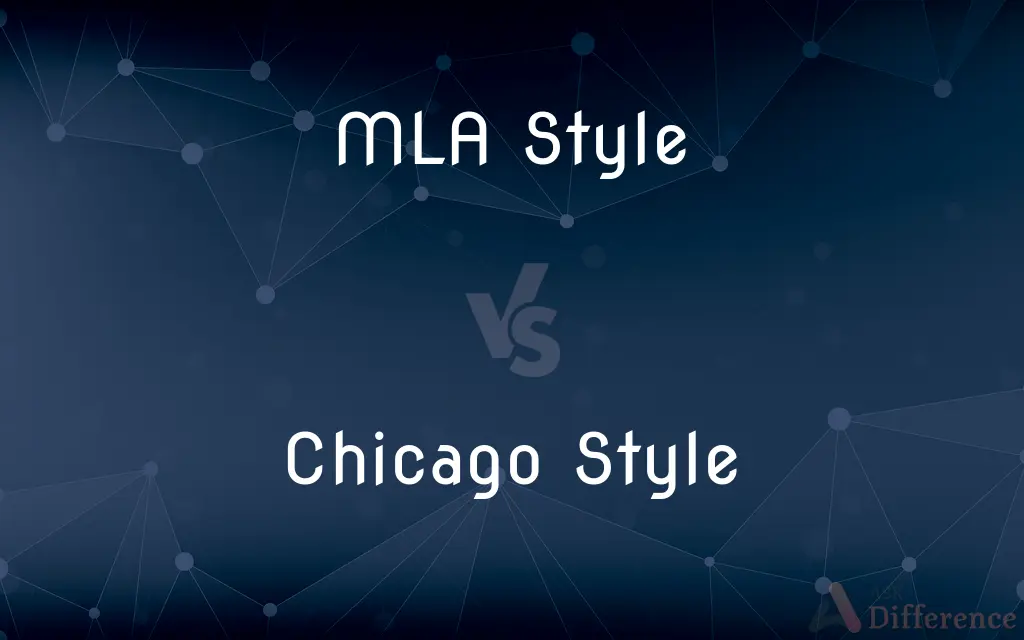MLA Style vs. Chicago Style — What's the Difference?
By Tayyaba Rehman & Maham Liaqat — Published on October 4, 2024
MLA Style emphasizes concise in-text citations and a Works Cited page, ideal for humanities, while Chicago Style offers flexibility with footnotes or author-date citations, suited for a broad range of disciplines.

Difference Between MLA Style and Chicago Style
Table of Contents
ADVERTISEMENT
Key Differences
MLA Style is known for its simplicity and focus on the author-page format for in-text citations, primarily used in the humanities. This method allows readers to find the source in the Works Cited page easily.
Chicago Style, on the other hand, provides two documentation systems: the Notes-Bibliography system for literature, history, and the arts, and the Author-Date system for social sciences. This flexibility makes it applicable across various academic fields.
In MLA Style, the Works Cited page lists all references used in the paper, formatted with specific guidelines for different types of sources. This focus on consistency ensures clarity and ease of access for readers.
Chicago Style's Notes-Bibliography system uses detailed footnotes or endnotes for each citation, followed by a bibliography. This method accommodates extensive source information, offering more context within the text.
Both styles require specific formatting rules for the document, including margins, fonts, and spacing. However, MLA Style generally has more straightforward guidelines, whereas Chicago Style's comprehensive manual covers a wide array of formatting details.
ADVERTISEMENT
Comparison Chart
Primary Use
Humanities
Broad range, including history and sciences
In-text Citation
Author-page number
Footnotes/endnotes or author-date
Bibliography Page
Works Cited
Bibliography or References
Formatting
Less rigid, simpler
More flexible, detailed
Documentation System
Singular system
Dual system (Notes-Bibliography, Author-Date)
Compare with Definitions
MLA Style
MLA Style requires in-text citations for any paraphrased or quoted material.
The phenomenon was described as unprecedented (Brown 22).
Chicago Style
Chicago Style's Notes-Bibliography system uses footnotes for detailed citations.
Smith argues that the methodology was flawed.^1
MLA Style
MLA Style emphasizes brief parenthetical citations within the text.
According to Jones (99), the data was inconclusive.
Chicago Style
Chicago Style bibliography entries are formatted with specific guidelines.
Johnson, David. 2020. Explorations in Quantum Physics. Cambridge UP.
MLA Style
MLA Style avoids footnotes for citations, focusing instead on in-text clarity.
The debate over methodology remains contentious (Green 45).
Chicago Style
The Author-Date system in Chicago Style is preferred in the sciences.
Recent studies confirm this hypothesis (Johnson 2020).
MLA Style
The MLA handbook outlines specific formatting and citation guidelines.
The MLA Handbook suggests a standard font size and margin width.
Chicago Style
Footnotes in Chicago Style can include full publication details or abbreviated forms.
For a comprehensive review, see Thompson.^2
MLA Style
Works Cited pages in MLA list sources alphabetically by authors' last names.
Smith, John. Understanding the Cosmos. Oxford UP, 2020.
Chicago Style
The Chicago Manual of Style provides extensive guidelines for editors and authors.
According to the Chicago Manual, tables should be used sparingly.
Common Curiosities
Can I use MLA Style for scientific papers?
MLA Style is typically used in the humanities, but it can be adapted for simpler scientific papers that don't require extensive citations.
Can I switch between the two styles in one document?
No, it's important to maintain consistency by using one style throughout your document to ensure clarity and coherence.
Do both styles require a title page?
MLA Style usually doesn't require a title page for essays, while Chicago Style often does, especially for formal papers and publications.
What is the difference in citing a journal article in both styles?
MLA requires the author(s), article title, journal name, volume, issue, pages, and year, while Chicago's format depends on whether you're using the Notes-Bibliography or Author-Date system.
Is the bibliography formatted the same in both styles?
No, each style has specific guidelines for formatting entries in the Works Cited (MLA) or Bibliography (Chicago) page.
How do I cite a website in MLA Style?
In MLA, you include the author's name, the title of the page, the website name, the publication date, and the URL.
How do I cite a film in MLA Style?
Cite the film by its title, director's name, distributor, release year, and the medium.
Is Chicago Style suitable for humanities?
Yes, Chicago Style is very versatile and is often used in humanities, especially history, due to its detailed citation format.
Are in-text citations the same in both styles?
No, MLA uses author-page format in-text citations, while Chicago can use footnotes, endnotes, or author-date in-text citations.
Can I use personal communications as sources in either style?
Yes, both styles allow for the citation of personal communications, but the formatting differs between the two.
How is an encyclopedia article cited in Chicago Style?
In the Notes-Bibliography system, include the article title, encyclopedia name, edition, publication year, and page numbers in the footnote or endnote.
What is the main advantage of using MLA Style?
MLA Style's main advantage is its simplicity and ease of use, making it ideal for writing in the humanities.
How do I cite a book in Chicago Style?
For a book in Chicago's Notes-Bibliography system, you include the author's name, book title, place of publication, publisher, and year of publication in the footnote or endnote.
How do I format quotations longer than four lines in MLA?
In MLA, quotations longer than four lines should be formatted as a block quote, indented one inch from the left margin.
What is a significant benefit of the Chicago Style?
Chicago Style's flexibility and detailed guidelines make it suitable for a wide range of disciplines, offering comprehensive instructions for various source types.
Are URLs required in both citation styles?
URLs are included in both styles for online sources, but the formatting rules vary.
Share Your Discovery

Previous Comparison
FCC vs. HCP
Next Comparison
Thai Food vs. Chinese FoodAuthor Spotlight
Written by
Tayyaba RehmanTayyaba Rehman is a distinguished writer, currently serving as a primary contributor to askdifference.com. As a researcher in semantics and etymology, Tayyaba's passion for the complexity of languages and their distinctions has found a perfect home on the platform. Tayyaba delves into the intricacies of language, distinguishing between commonly confused words and phrases, thereby providing clarity for readers worldwide.
Co-written by
Maham Liaqat













































